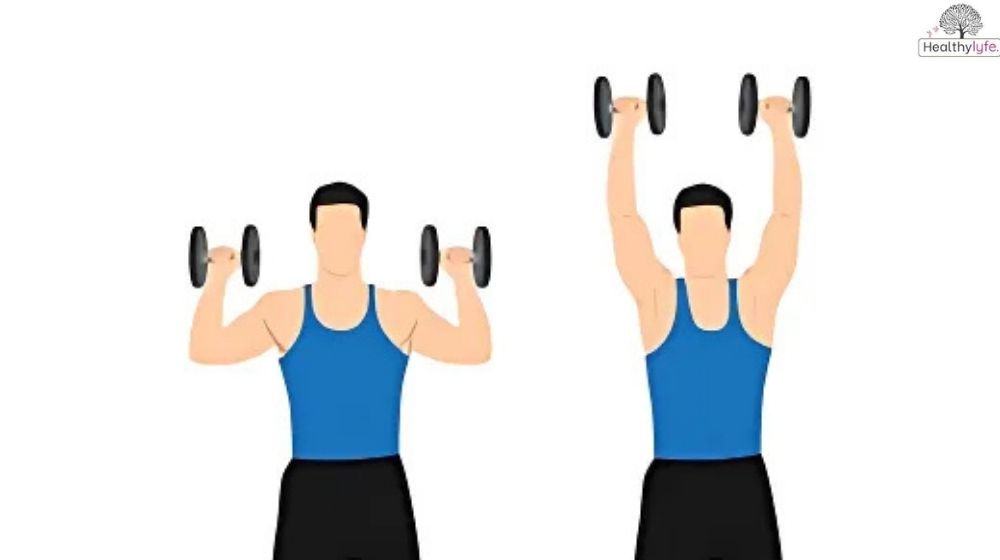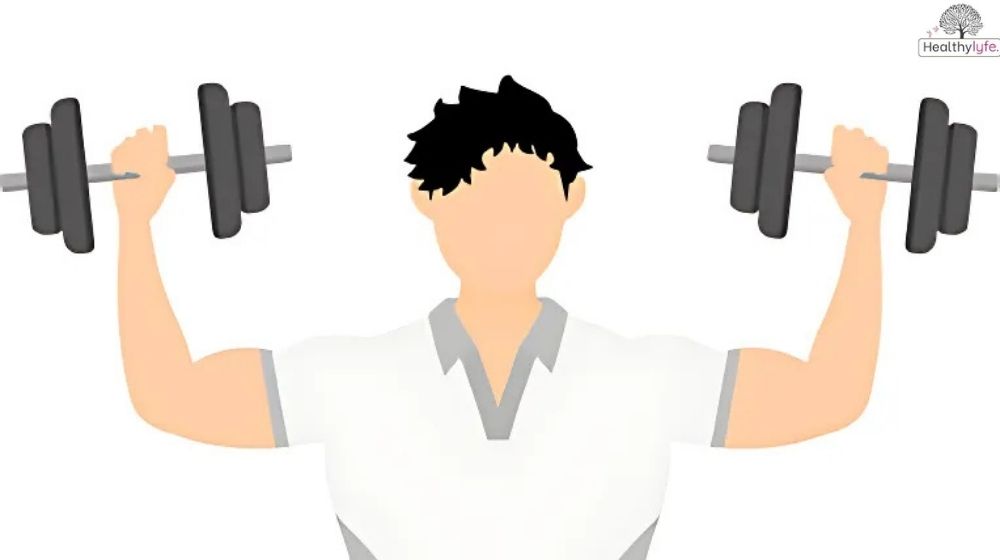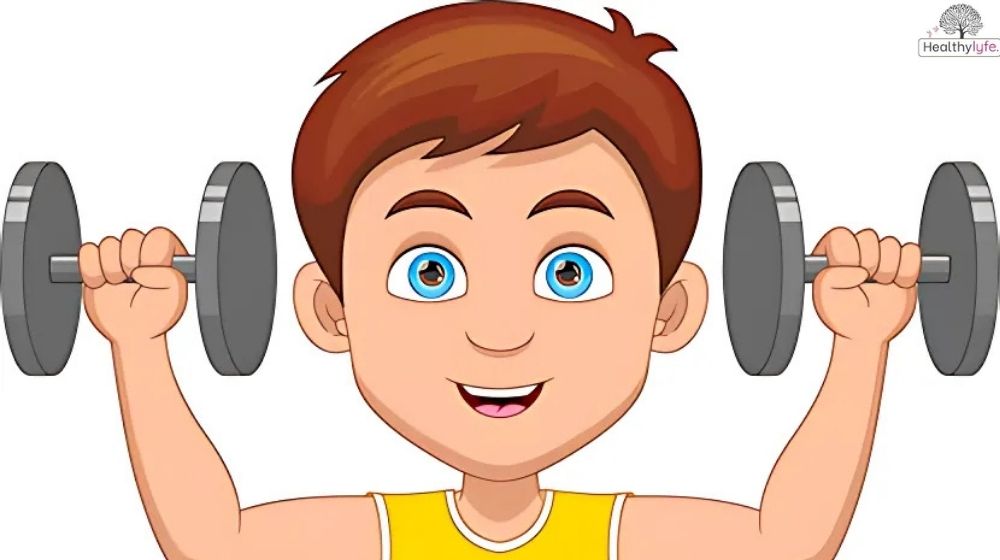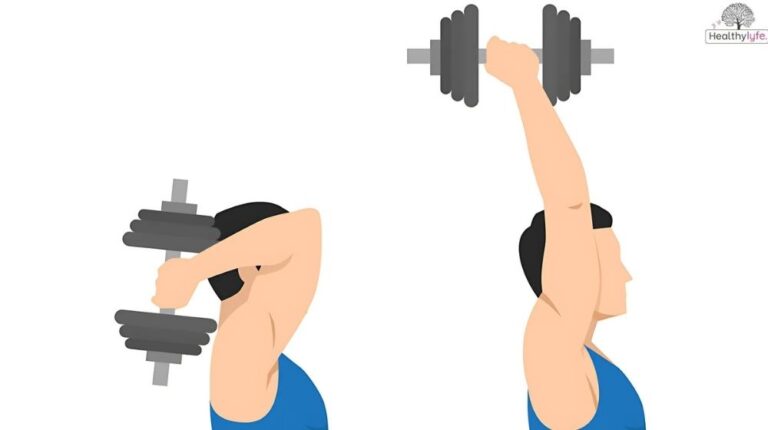Learn why the Standing Overhead Dumbbell Press is great for building strength and protecting your joints. Perfect for shoulders and core stability.
Introduction
The Standing Overhead Dumbbell Press is a powerful exercise that targets the shoulders, arms, and core. It’s not only effective for building muscle but also gentler on the joints compared to other pressing movements. Unlike the seated version, the standing press engages more muscles for stability. This helps to improve overall balance while strengthening your shoulders and arms. It also promotes a natural range of motion, which is great for joint health, especially around the shoulders. The standing position reduces strain on the spine and lower back, making it a safer option for many people.
What is Standing Overhead Dumbbell Press?
The Standing Overhead Dumbbell Press is a strength training exercise that primarily targets the shoulders, arms, and upper chest. Performed while standing, this exercise involves lifting two dumbbells from shoulder height to an overhead position, extending the arms fully. The movement requires stability and coordination, as you must engage your core and lower body to maintain balance throughout the lift.

This exercise is a variation of the traditional overhead press and offers the added benefit of improving posture and engaging more muscles, such as the core and legs, for stabilization. It’s a great choice for building upper body strength while also promoting functional movement, making it a valuable addition to any workout routine.
Types of Standing Overhead Dumbbell Press
The Standing Overhead Dumbbell Press is a versatile exercise with several variations that can target the upper body and core in slightly different ways. Each variation offers unique benefits, allowing you to tailor your workout based on your fitness goals. Here are the most common types:
- Standard Standing Overhead Dumbbell Press
This is the traditional version where you hold a dumbbell in each hand at shoulder height and press them straight overhead. The movement primarily targets the deltoids (shoulders), but it also works the triceps, upper chest, and core. It’s a great all-around upper body exercise. - Alternating Standing Overhead Dumbbell Press
In this variation, you press one dumbbell overhead at a time, alternating between your left and right arm. This allows you to focus on one shoulder at a time and helps improve unilateral strength and coordination. It also places less strain on the body, which can be helpful for beginners. - Dumbbell Push Press
The Push Press adds a slight leg drive to the overhead movement. By bending your knees and using your lower body to help propel the dumbbells overhead, you can lift heavier weights and improve explosive power. This variation also engages the legs and core more than the standard press. - Arnold Press
Named after Arnold Schwarzenegger, this variation starts with the dumbbells in front of the shoulders, palms facing your body. As you press the weights overhead, you rotate your wrists so that your palms face forward at the top. The Arnold Press increases shoulder engagement and promotes a fuller range of motion. - Neutral Grip Standing Dumbbell Press
In this version, you hold the dumbbells with your palms facing each other (neutral grip) rather than having them face forward. This grip may reduce strain on the wrists and shoulders, making it a good option for individuals with joint issues or those looking for a different angle of shoulder activation.
Benefits of Standing Overhead Dumbbell Press [1]
The Standing Overhead Dumbbell Press is a powerful exercise that can help you build strength, improve posture, and increase functional fitness. Whether you’re a beginner or an advanced lifter, this exercise offers a variety of benefits that make it a great addition to any workout routine. Here’s why you should include the Standing Overhead Dumbbell Press in your training:

Builds Shoulder Strength
The Standing Overhead Dumbbell Press is one of the best exercises to strengthen your shoulders. By lifting dumbbells overhead, you work all three parts of the shoulder muscles (front, middle, and rear deltoids). Strong shoulders not only improve your appearance but also make everyday tasks like lifting objects easier.
Engages Your Core
One of the unique benefits of the Standing Overhead Dumbbell Press is that it engages your core muscles for balance and stability. While you press the dumbbells overhead, your abdominals and lower back work hard to keep your body upright. This helps to strengthen your core and improve overall posture.
Improves Upper Body Strength
In addition to the shoulders, this exercise also targets the triceps, upper chest, and traps. Working these muscles together helps you build overall upper body strength, which is essential for various activities, such as lifting, pushing, and pulling. Whether you’re looking to improve your fitness for daily life or other exercises, this press is highly effective.
Promotes Functional Strength
The Standing Overhead Dumbbell Press mimics movements you use in daily activities, such as lifting a heavy box overhead. By improving your functional strength, this exercise helps you perform real-world tasks with more ease and reduces the risk of injury. It also helps to improve your overall physical coordination and movement patterns.
Enhances Joint Health
The Standing Overhead Dumbbell Press encourages a natural range of motion in the shoulder joints, which can improve flexibility and mobility over time. Unlike machines that limit movement, using dumbbells allows for better shoulder mobility and can help prevent stiffness. This is especially beneficial for maintaining joint health as you age.
Improves Posture
Performing the Standing Overhead Dumbbell Press requires you to maintain an upright posture throughout the movement. This helps activate the muscles in your back and core, which support good posture. Regularly practicing this exercise can help improve posture and reduce the risk of slouching, which is especially beneficial for people who sit for long periods each day.
Boosts Calorie Burn
Because you are standing while performing the overhead press, your legs and core also play a role in stabilizing your body. This leads to greater calorie burn compared to seated exercises, as more muscle groups are being engaged. If you’re looking to lose weight or improve overall fitness, the Standing Overhead Dumbbell Press can be a great addition to your routine.
Enhances Balance and Coordination
Since the Standing Overhead Dumbbell Press requires you to stabilize the weight while standing, it improves your overall balance and coordination. This helps develop better body control, making you less prone to falls and injuries in daily life. Improving balance and coordination is crucial for maintaining independence as you age.
Versatile and Customisable
The Standing Overhead Dumbbell Press can be easily modified to suit your fitness level and goals. You can adjust the weight, the number of reps, or the speed of the movement to make it more challenging. Additionally, you can try variations like the alternating press or Arnold press to target your muscles in different ways.
Supports Full-Body Activation
Unlike seated versions of overhead presses, the standing position activates your legs, glutes, and core to stabilize your body. This leads to full-body activation, which is great for building overall strength and improving athletic performance. Plus, it makes the exercise more dynamic and functional.
Diet Plan for Standing Overhead Dumbbell Press
When training with the Standing Overhead Dumbbell Press, it’s essential to fuel your body with the right nutrients to support muscle growth, recovery, and overall performance. A well-balanced diet that includes protein, healthy fats, and carbohydrates will provide the energy needed for your workouts and promote muscle repair afterward. Below is a simple, effective diet plan to complement your training and optimize results.
| Meal | Foods | Purpose/Benefits |
|---|---|---|
| Breakfast | Scrambled eggs, whole grain toast, avocado, and a banana | High in protein and healthy fats to support muscle repair and provide sustained energy for workouts. |
| Mid-Morning Snack | Greek yogurt with berries and a handful of almonds | Protein for muscle maintenance and healthy fats for sustained energy. |
| Lunch | Grilled chicken breast, quinoa, mixed greens, olive oil dressing | Lean protein for muscle growth, complex carbs for energy, and fiber for digestion. |
| Afternoon Snack | Apple with peanut butter | Carbs for quick energy, protein, and healthy fats to sustain energy levels. |
| Pre-Workout | Oats with almond butter and chia seeds | Provides a steady release of energy to fuel the Standing Overhead Dumbbell Press and other workouts. |
| Post-Workout | Protein shake (whey or plant-based), with a banana | Rapid muscle recovery with protein and carbs to replenish glycogen stores. |
| Dinner | Salmon, sweet potato, steamed broccoli | Omega-3s for joint health, protein for muscle repair, and carbs for recovery. |
| Evening Snack | Cottage cheese with a few slices of pineapple | Slow-digesting protein to support muscle repair overnight. |
Key Considerations:
- Protein: Essential for muscle growth and recovery. Aim for 1.2 to 2.0 grams of protein per kilogram of body weight.
- Carbohydrates: Needed for energy, especially around workout times. Choose complex carbs like oats, quinoa, and sweet potatoes.
- Fats: Healthy fats from sources like avocado, olive oil, nuts, and fatty fish are important for hormone regulation and joint health.
- Hydration: Drink plenty of water throughout the day to stay hydrated, particularly before, during, and after workouts.
Tips for Standing Overhead Dumbbell Press
The Standing Overhead Dumbbell Press is an effective exercise, but to get the most out of it and prevent injury, it’s important to use proper form and technique. Here are some essential tips to help you perform the exercise safely and effectively, ensuring that you maximize your strength and results:

Engage Your Core
Before starting the press, engage your core muscles (abdominals and lower back) to stabilize your torso. A strong core will help you maintain balance and protect your lower back during the movement. Focus on tightening your abs as you press the dumbbells overhead.
Keep Your Feet Hip-Width Apart
Stand with your feet about hip-width apart to maintain a stable base. This position will help you balance better and distribute your weight evenly across your legs. Avoid standing too wide or too narrow, as this could compromise your balance and form.
Avoid Arching Your Back
As you press the dumbbells overhead, ensure that your back remains straight and neutral. Avoid arching your lower back, as this can lead to unnecessary strain. If you feel like you’re arching your back, reduce the weight or focus on tightening your core to maintain proper posture.
Use a Full Range of Motion
To effectively target the shoulder muscles, make sure you press the dumbbells all the way overhead and extend your arms fully. Lower the dumbbells back down to shoulder height in a controlled manner. A full range of motion will help engage all parts of the deltoid muscles and improve shoulder mobility.
Focus on Controlled Movement
Perform the press with slow, controlled movements. Avoid using momentum or jerking the weights upward. This ensures that the muscles are doing the work rather than relying on your body’s natural inertia. Control both the upward and downward phases of the lift.
Start with Lighter Weights
If you’re new to the Standing Overhead Dumbbell Press, start with lighter weights to master the technique. This will allow you to focus on form before increasing the weight. As you get stronger, gradually increase the weight to continue challenging your muscles.
Keep Dumbbells Aligned with Your Ears
As you press the dumbbells overhead, ensure that they are aligned with your ears. This position helps to avoid excessive strain on your shoulders and elbows. Do not let the dumbbells drift too far forward or backward, as this can lead to improper alignment and potential injury.
Don’t Lock Your Elbows
When you reach the top of the press, avoid locking your elbows fully. Keeping a slight bend in your elbows ensures constant tension on the shoulder muscles, which helps to maintain muscle activation throughout the movement.
Breathe Properly
Proper breathing is key to maintaining energy and focus during the lift. Inhale as you lower the dumbbells to shoulder height, and exhale as you press them overhead. Keeping a steady breathing rhythm helps you maintain control and prevents unnecessary tension in your body.
Warm Up and Stretch
Always perform a warm-up before starting any overhead pressing exercise. Focus on dynamic stretches and movements that engage the shoulders, arms, and core. This will help improve mobility and reduce the risk of injury.
Conclusion
The Standing Overhead Dumbbell Press is a great exercise for building upper body strength and improving posture. It works the shoulders, arms, and core, while also helping with balance and coordination. This exercise is effective for anyone looking to increase strength, improve joint health, and enhance overall fitness.
FAQs about Standing Overhead Dumbbell Press
What muscles does the Standing Overhead Dumbbell Press work?
The primary muscles worked are the deltoids (shoulders), with secondary activation of the triceps, upper chest, traps, and core muscles for stabilisation.
What is the correct form for a Standing Overhead Dumbbell Press?
Stand with feet shoulder-width apart, dumbbells at shoulder height with palms facing forward. Engage your core, press the dumbbells overhead until arms are fully extended, then lower them back to the starting position.
Should I use a neutral grip or palms-forward grip?
A neutral grip (palms facing each other) may reduce strain on the shoulders and wrists. A palms-forward grip emphasises the deltoids more and is common in traditional pressing.
How much weight should I use?
Start with a weight that allows you to perform 8-12 reps with proper form. Gradually increase as you build strength.
How many sets and reps are recommended?
For strength: 4-6 sets of 4-6 reps
For hypertrophy: 3-4 sets of 8-12 reps
For endurance: 2-3 sets of 12-15 reps
How does it compare to the seated version?
The standing version engages the core and stabilisers more, while the seated version isolates the shoulders by reducing lower-body involvement.
Is the Standing Overhead Dumbbell Press safe for beginners?
Yes, if performed with proper form and light weights. Beginners should focus on technique and core stability.
What are common mistakes to avoid?
Overarching the back
Flaring elbows too wide
Using too much weight
Not fully engaging the core
Uneven pressing of the dumbbells
How can I improve my overhead press strength?
Incorporate accessory exercises like push presses, lateral raises, tricep dips, and core strengthening exercises. Gradual progressive overload also helps.
Can it help with building bigger shoulders?
Yes, it is an excellent compound exercise for shoulder hypertrophy when combined with proper diet and progressive overload.
Should I lock out my elbows at the top?
Locking out slightly can improve triceps activation but avoid hyperextending to prevent joint strain.
Does it help improve posture?
Yes, the exercise strengthens shoulder and upper back muscles, which can help correct poor posture when combined with stretching.
Can I perform it with one dumbbell at a time?
Yes, a unilateral overhead dumbbell press improves balance, reduces muscle imbalances, and engages the core more.
How can I avoid lower back pain during the press?
Engage your core, avoid overarching the lower back, and consider slightly bending your knees for additional stability.
What are good warm-ups for this exercise?
Warm-ups include shoulder circles, arm swings, lightweight presses, or banded exercises to prepare the joints and muscles.
Disclaimer: The information provided in this article is for general informational purposes only and is not intended as medical advice. Always consult with a healthcare professional or certified fitness trainer before starting any new exercise.
By healthylyfe


